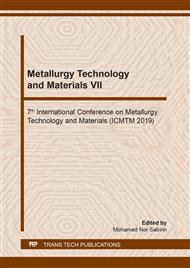[1]
V.A. Sakkas, M.A. Islam, C. Stalikas, T.A. Albanis, Photocatalytic degradation using design of experiments: A review and example of the Congo red degradation, Journal of Hazardous Materials, 175 (2010) 33-44.
DOI: 10.1016/j.jhazmat.2009.10.050
Google Scholar
[2]
N.H. Abdullah, K. Shameli, E.C. Abdullah, L.C. Abdullah, Solid matrices for fabrication of magnetic iron oxide nanocomposites: Synthesis, properties, and application for the adsorption of heavy metal ions and dyes, Composites Part B: Engineering, 162 (2019) 538-568.
DOI: 10.1016/j.compositesb.2018.12.075
Google Scholar
[3]
K. Naseem, Z.H. Farooqi, R. Begum, A. Irfan, Removal of Congo red dye from aqueous medium by its catalytic reduction using sodium borohydride in the presence of various inorganic nano-catalysts: A review, Journal of Cleaner Production, 187 (2018) 296-307.
DOI: 10.1016/j.jclepro.2018.03.209
Google Scholar
[4]
K.C. Lai, L.Y. Lee, B.Y.Z. Hiew, Suchithra Thangalazhy-Gopakumar, Suyin Gan, Environmental application of three-dimensional graphene materials as adsorbents for dyes and heavy metals: Review on ice-templating method and adsorption mechanisms, Journal of Environmental Sciences, 79 (2019) 174-199.
DOI: 10.1016/j.jes.2018.11.023
Google Scholar
[5]
T.V. Tran, D.T.C. Nguyen, H.T.N. Le, C.D. Duong, L.G. Bach, H.T.T. Nguyen, T.D. Nguyen, Facile synthesis of manganese oxide-embedded mesoporous carbons and their adsorbability towards methylene blue, Chemosphere 227 (2019) 455-461.
DOI: 10.1016/j.chemosphere.2019.04.079
Google Scholar
[6]
V.T. Pham, H.T.T. Nguyen, D.T.C. Nguyen, H.T. N. Le, T.T. Nguyen, N.T.H. Le, K.T. Lim, T.D. Nguyen, T.V. Tran and L.G. Bach, Process Optimization by a Response Surface Methodology for Adsorption of Congo Red Dye onto Exfoliated Graphite-Decorated MnFe2O4 Nanocomposite: The Pivotal Role of Surface Chemistry, Processes 2019, 7, 305;.
DOI: 10.3390/pr7050305
Google Scholar
[7]
T.V. Tran, Q.T.P. Bui, T.D. Nguyen, N.T.H. Le, L.G. Bach, A comparative study on the removal efficiency of metal ions (Cu+2, Ni+2, and Pb2+) using sugarcane bagasse derived ZnCl2-activated carbon by the response surface methodology, Adsorption Science & Technology 2017, vol. 35(1–2), p.72–85.
DOI: 10.1177/0263617416669152
Google Scholar
[8]
T.V. Tran, Q.T.P. Bui, T.D. Nguyen, V.T.T. Ho, L.G. Bach, Application of response surface methodology to optimize the fabrication of ZnCl2- activated carbon from sugarcane bagasse for the removal of Cu2+, Water Science & Technology, vol. 75, no.9, 2017, pp.2047-2055.
DOI: 10.2166/wst.2017.066
Google Scholar
[9]
T.V. Thuan, B.T.P. Quynh, T.D. Nguyen, L.G. Bach, Response surface methodology approach for optimization of Cu2+, Ni2+ and Pb2+ adsorption using KOH-activated carbon from banana peel, Surfaces and Interfaces, vol. 6, 2017, pp.209-217.
DOI: 10.1016/j.surfin.2016.10.007
Google Scholar
[10]
L.G. Bach, T.V. Tran, T.D. Nguyen, T.V. Pham, S.T. Do, Enhanced adsorption of methylene blue onto graphene oxide-doped XFe2O4 (X = Co, Mn, Ni) nanocomposites: kinetic, isothermal, thermodynamic and recyclability studies, Research on Chemical Intermediates, vol. 44, no. 3, 2018, p.1661–1687.
DOI: 10.1007/s11164-017-3191-1
Google Scholar
[11]
L.G. Bach, M.R. Islam, X.T. Cao, J.M. Park, K.T. Lim, A novel photoluminescent nanohybrid of poly(ε-Caprolactone) grafted Mg/Al layered double hydroxides and Tb3+ ions: synthesis and characterization, Journal of Alloys and Materials, 582 (2014) 22-28.
DOI: 10.1016/j.jallcom.2013.07.186
Google Scholar
[12]
B. Zhang, Z. Dong, D. Sun, T. Wu, and Y. Li, Enhanced adsorption capacity of dyes by surfactant-modified layered double hydroxides from aqueous solution,, J. Ind. Eng. Chem., vol. 49, no. 2016, p.208–218, (2017).
DOI: 10.1016/j.jiec.2017.01.029
Google Scholar
[13]
C. Xing, F. Musharavati, H. Li, E. Zalezhad, O.K. S. Hui, S. Bae, B.Y. Cho, Synthesis, characterization, and properties of nickel-cobalt layered double hydroxide nanostructures," RSC Adv., 7 (2017) 38945-38950.
DOI: 10.1039/c7ra06670h
Google Scholar
[14]
Y. Li, W. Nie, P. Chen, and Y. Zhou, Preparation and characterization of sulfonated poly (styrene-alt-maleic anhydride) and its selective removal of cationic dyes, Colloids Surfaces A Physicochem. Eng. Asp., 499 (2016) 46-53.
DOI: 10.1016/j.colsurfa.2016.04.009
Google Scholar
[15]
D. Kang, X. Yu, S. Tong, M. Ge, J. Zuo, C. Cao, W. Song, Performance and mechanism of Mg/Fe layered double hydroxides for fluoride and arsenate removal from aqueous solution, Chem. Eng. J., 228 (2013) 731-740.
DOI: 10.1016/j.cej.2013.05.041
Google Scholar


